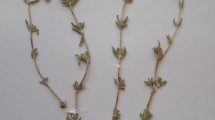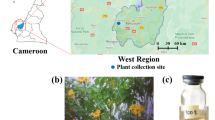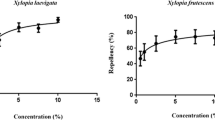Abstract
N,N-Diethyl-m-methylbenzamide (DEET)-based repellents may provoke dermal toxicity in infants and children. For use against mosquitoes, various plant-derived essential oils are considered useful alternatives to such synthetic chemicals. The present study was undertaken to scientifically evaluate the repellency of 33 essential oils against female Culex pipiens pallens adults. By using the ASTM E951-94 apparatus with human volunteers, we showed that the 33 essential oils exhibited varying degrees of mosquito repellency. Four oils, namely, clove bud, clove leaf, juniperberry and majoram, showed good repellency at a concentration of 0.005 mg/cm2. The clove bud and clove leaf oils had higher repellency than citronella known as a commercial repellent ingredient. Analysis of the clove bud and clove leaf oils by GC and GC-MS revealed their major components. Repellency analysis of these individual components indicated that isoeugenol, a major component of clove bud oil, had the highest repellency, while eugenol, a major component of both clove oils, was also more repellent than citronella. Clove bud oil, which was the most repellent of all tested oils, exhibited the prolonged repellency when mixed with vanillin for long-term use. Clove bud oil clearly had higher repellency than commercial repellents. Further research on means to prolong the repellency of this oil will be necessary before it can replace DEET.
Similar content being viewed by others
Abbreviations
- DEET:
-
N,N-diethyl-m-methylbenzamide
- ASTM:
-
American society for testing and materials
References
Amer A and Melhorn H (2006) Repellency effect of forty-one essential oils against Aedes, Anopheles, and Culex mosquitoes. Parasitol Res 99, 478–490.
Ansari MA, Mittal PK, Razdan RK, and Sreehari U (2005) Larvicidal and mosquito repellent activities of Pine (Pinus longifolia, Family: Pinaceae) oil. J Vector Borne Dis 42, 95–99.
ASTM E951-94 (2000) Standard test methods for laboratory testing of non-commercial mosquito repellent formulation on the skin. American Society for Testing and Materials. ASTM-E951-94 (Reapproved 2000).
Barnard D (1999) Repellency of essential oils to mosquitoes (Diptera: Culicidae). J Med Entomol 36, 625–629.
Bowers WS, Sener B, Evans PH, Bingol F, and Erdogan I (1995) Activity of Turkish medicinal plants against mosquitoes Aedes aegypti and Anopheles gambiae. Insect Sci Appl 16, 339–342.
Cheon MS, Yoon T, Yasukawa K, Yu SY, Kim SJ, Choi G, Moon BC, Lee AY, Choo BK, and Kim HK (2009) Effects of Aralia continentalis and Angelica biserrata on inflammatory response in lipopolysaccharide-induced RAW 264.7 macrophage and phorbol ester-induced ear dema. J Korean Soc Appl Biol Chem 52, 157–162.
Curtis CF, Lines JD, Lu B, and Renz A (1990) Natural and synthetic repellents. In Appropriate Technology in Vector Control. Curtis CF (ed.), pp. 75–92. CRC Press, Boca Raton, Florida, USA.
Erler F, Ulug I, and Yalcinkaya B (2006) Repellent activity of five essential oils against Culex pipiens. Fitoterapia 77, 491–494.
Fradin MS and Day JF (2002) Comparative efficacy of insect repellents against mosquito bites. New Engl J Med 347, 13–18.
Gupta RK and Rutledge LC (1989) Laboratory evaluation of controlled-release repellent formulations on human volunteers under three climatic regimens. J Am Mosq Cont Assoc 5, 52–55.
Huang A, Ho SH, Lee HC, and Yap YC (2002) Insecticidal properties of eugenol, isoeugenol and methyleugenol and their effects on nutrition of Sitophilus zeamais Motsch. (Coleoptera: Curculionidae) and Tribolium castaneum (Herbst) (Coleoptera: Tenebrionidae). J Stored Pros Res 38, 403–412.
Kim EH, Kim HK, Choi DH, and Ahn YJ (2003) Acaricidal activity of clove bud oil compounds against Tyrophagus putrescentiae (Acari: Acaridae). Appl Entamol Zool 38, 261–266.
Koeduka T, Fridman E, Gang DR, Vassao DG, Jackson BL, Kish CM, Orlova I, Spassova SM, Lewis NG, Noel JP, Baiga TJ, Dudareva N, and Pichersky E (2006) Eugenol and isoeugenol, characteristic aromatic constituents of spices, are biosynthesized via reduction of a coniferyl alcohol ester. Proc Natl Acad Sci 103, 10128–10133.
Lee IH, Seol MS, and Park JD (2005) Repellent and pesticidal effect of Ginkgo biloba leaves extracts on the Tetranychus urticae, Aphis gossypii and Myzus persicae. J Korean Soc Appl Biol Chem 48, 150–154.
Lee KG and Shibamoto T (2001) Antioxidant property of aroma extract isolated from clove buds [Syzygium aromaticum (L.) Merr. Et Perry]. Food Chem 74, 443–448.
Masetti A and Maini S (2006) Arm in cage tests to compare skin repellents against bites of Aedes albopictus. Bull Insectol 59, 157–160.
Menon KS and Brown AE (2005) Exposure of children to Deet and other topically applied insect repellents. Am J Industrial Med 47, 91–97.
Myint S, Wan Daud WR, Mohamad AB, and Kadhum AAH (1996) Gas chromatographic determination of eugenol in ethanol extract of cloves. J Chromatography B 679, 193–195.
Park JM, Lee JY, Park TS, Hyun SJ, Kim HH, Cho YJ, Kwon OJ, Son AR, Kim DS, and An BJ (2008) A study on the cosmeceutical activities of Prunus sargenta R. J Korean Soc Appl Biol Chem 51, 70–78.
Prajapati V, Tripathi AK, Aggarwal KK, and Khanuja SPS (2005) Insecticidal, repellent and oviposition-deterrent activity of selected essential oils against Anopheles stephensi, Aedes aegypti and Culex quinquefasciatus. Bioresource Technol 96, 1749–1757.
Raina VK, Srivastava SK, Aggarwal KK, Syamasundar KV, and Kumar S (2001) Essential oil composition of Syzygium aromaticum leaf from Little Andaman. India Flav Fragr J 16, 334–336.
Rozendaal JA (1997) In Vector control. WHO, Geneva, Switzerland.
Rueda LM, Rutledge LC, and Gupta RK (1998) Effect of skin abrasion on the efficacy of the repellent deet against Aedes aegypti. J Am Mosq Control Assoc 14, 178–182.
SAS Institute (1999) In SAS User’s Guide. SAS Institute, Cary, NC.
Tawatsin A, Wratten SD, Roderic Scott R, Thavara U, and Techadamronsm Y (2001) Repellency of volatile oils from plants against three mosquito vectors. J Vector Ecol 26, 76–82.
Trongtokit Y, Rongsriyam Y, Komalamisra N, and Apiwath-nasorn C (2005) Comparative repellency of 38 essential oils against mosquito bites. Phytother Res 19, 303–309.
Yang P, Ma Y, and Zheng S (2005) Adulticidal activity of five essential oils against Culex pipiens quinquefasciatus. J Pestic Sci 30, 84–89.
Zhu J, Zeng X, Ting Liu Y, Qian K, Han Y, Xue S, Tucker B, Schultz G, Coats J, Rowley W, and Zhang A (2006) Adult repellency and larvicidal activity of five plant essential oils against mosquitoes. J Am Mosq Control Assoc 22, 515–522.
Author information
Authors and Affiliations
Corresponding author
Rights and permissions
About this article
Cite this article
Kang, SH., Kim, MK., Seo, DK. et al. Comparative repellency of essential oils against Culex pipiens pallens (Diptera: Culicidae). J. Korean Soc. Appl. Biol. Chem. 52, 353–359 (2009). https://doi.org/10.3839/jksabc.2009.063
Received:
Accepted:
Issue Date:
DOI: https://doi.org/10.3839/jksabc.2009.063




